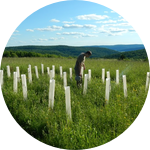About This Project
Mycorrhizae are fungi that live in the soil and form partnerships with plants, providing hard-to-find nutrients like nitrogen and phosphorus in exchange for sugar. Plants that rely on mycorrhizae tend to perform poorly in areas where their partners are not present. This project's goal is to test whether establishing mycorrhizae on American chestnut seedlings in the lab can improve their growth and survival in the field.Ask the Scientists
Join The DiscussionWhat is the context of this research?
The American chestnut was once the dominant tree in forests in the eastern United States, occupying a range that extended from Maine to Tennessee. In addition to providing forage for wildlife, it was an economically crucial member of the Appalachian forest. A popular anecdote refers to the chestnut as the "cradle-to-grave" tree, since its sturdy, rot-resistant wood was used in both cradles and caskets. Large picnics were held under the trees' wide canopies in the summer, and pigs were fattened on the nuts in the autumn. In 1904, the Asian chestnut blight arrived in the United States, carried there by chestnut specimens imported from China. This blight was lethal to American chestnuts, and, in a matter of a few decades, the tree was functionally extinct. Today, a few wild trees survive in isolated pockets.
Since then, researchers have attempted breeding breed blight-resistant trees in order to return the American chestnut to its former ecological and economic prominence. At present, several types of blight-resistant trees are ready for reintroduction. However, little research has been done on the belowground ecology of these plants; just as trees provide food and shelter for wildlife in their canopies, they make a home for fungi in their roots. The fungi that I focus on, mycorrhizae, form a vital partnership with their host plant, exchanging mineral nutrients in exchanged for energy in the form of sugar. Generally, this relationship is required for the fungus to survive and the plant to successfully compete with its neighbors.
What is the significance of this project?
Research on the benefits of ectomycorrhizae have been inconclusive, especially because it was carried out before the species specificity of many ectomycorrhizal groups was understood. This project will be able to use modern techniques to resolve some of this uncertainty.
Furthermore, much of the intensive research on ectomycorrhizae has focused on the small number of species that are easy to culture rather than attempt to replicate field conditions. Given the group-specificity of ectomycorrhizal fungi, it's probable that we'll see a different effect from soil inoculation.
The restoration of the American chestnut is going to be an arduous process at least until the first reintroduced trees mature and begin to produce seed, and probably long after that. Resources in this area aren't infinite, so anything that improves the survival and growth of these trees will increase the chances of success and reduce the financial burden on the participating labs and organizations.
What are the goals of the project?
This project intends to answer several questions simultaneously:
What fungi establish on lab-grown chestnuts?
After the chestnuts are planted and allowed to grow for a while, the root tips will be sampled and genetic analysis will be conducted on the fungi growing there to see (in comparison with field-based studies) if the mycorrhizal community in the lab is robust.
Is there a difference in quality between soils gathered from urban environments and forested environments?
If mycorrhizae are adopted into the chestnut reintroduction program, it will be carried out by a diverse group of land- and nursery managers, and it should be relatively easy for them to do. That said, soil gathered from Anycity Community Park, with its sunny lawns and frequent human disturbance, will probably not be as high-quality a source of fungi as an old growth forest. This project is designed to probe that continuum, using soil taken from in and around Syracuse as well as some old-growth areas where chestnut stumps can still be found.
Does pre-inoculation with mycorrhizae enhance the success of chestnut seedlings planted in different areas?
Once the lab component is done, it'll be time to see if the inoculated seedlings can hold their own in the wild. It's possible that, when it comes to well established forests, the mycorrhizal community will already be present in the soil and there may not be much of a difference. Then again, it could be that some isolated lab time might allow rarer species to get a foothold, and they won't have to compete as a hard for common species for precious root-tip real estate.
In addition, because chestnuts are being used for remediation of damaged and disturbed areas, such as former mines and clearcuts, where the mycorrhizal community is probably much smaller and less diverse, I want to test whether or not we can use this technique to repatriate lost fungal species in addition to lost plant
species.
Budget
Money raised by this project will go toward planting soil, growth chamber time, vehicle hire (to transport the seedlings to the site), and materials for DNA isolation and sequencing.
Meet the Team
Team Bio
Andrew holds a BS in Botany and a BA in English from the University of Maine. Originally drawn to the world of plants by an interest in carnivores, he eventually moved to habitat restoration, working on a wetland restoration project at UMaine for his undergraduate thesis. He also dabbles in ethnobotany and ethnomycology (see Morel Tales by Gary Fine).Project Backers
- 10Backers
- 18%Funded
- $445Total Donations
- $44.50Average Donation
